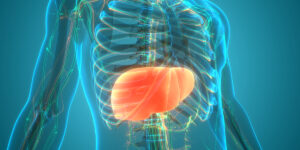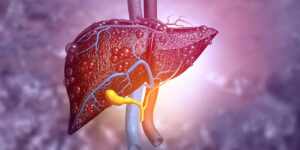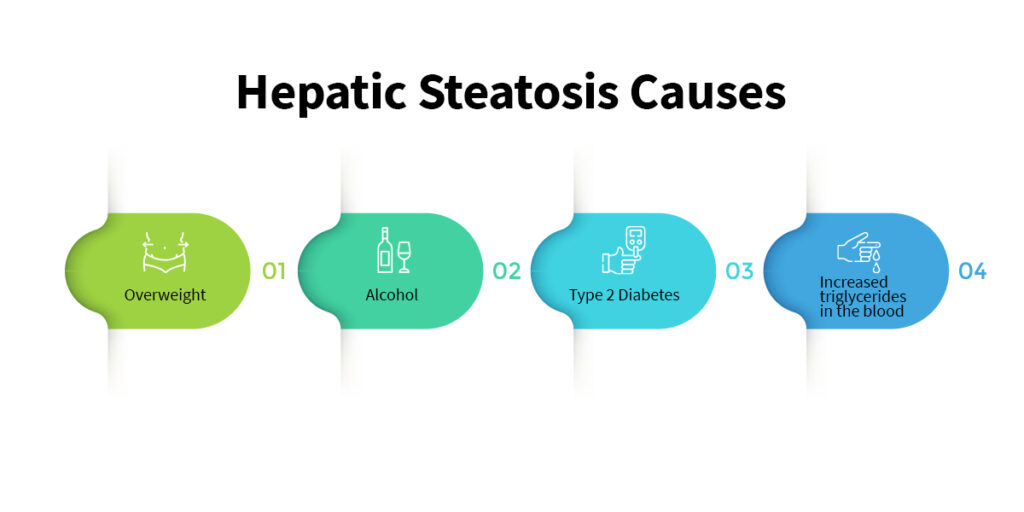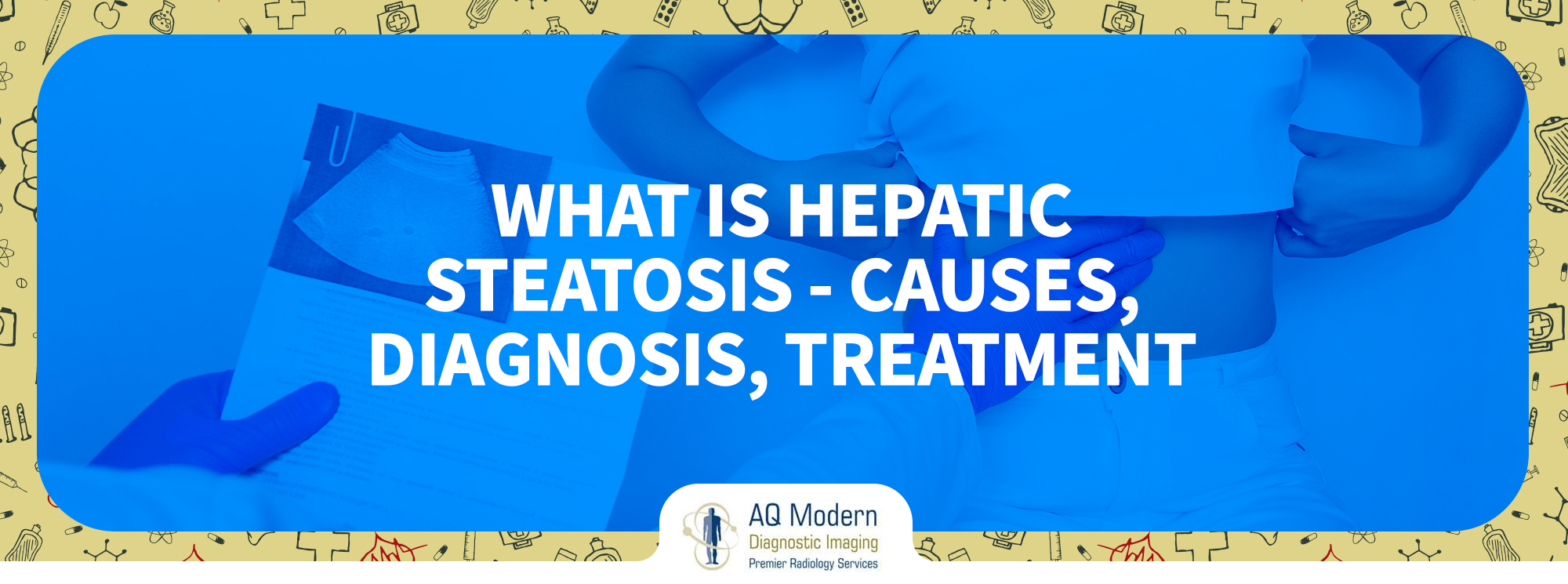An excessive buildup of fat causes Hepatic Steatosis in the liver. However, Hepatic Steatosis is also known as fatty liver disease. A healthy liver contains a minor amount of fat, and more fat deposition harms the liver. The liver is the second largest organ of the human body. It helps the body in processing the food we consume. In fact, too much fat deposition on the liver can cause liver inflammation.
A fatty liver has several symptoms. Moreover, it might consume excessive junk food or increase alcohol intake. There are various types of Fatty liver diseases. Fatty liver disease is initially divided into two types one is alcoholic and the other is nonalcoholic.
Types Of Hepatic Steatosis
The two common types of fatty liver diseases are listed below:
Nonalcoholic Fatty Liver Disease (NAFLD)

As the name implies, the nonalcoholic fatty liver disease only persists in people consuming little or no alcohol. However, the main characteristic of NAFLD is the excessive fat buildup on the liver. As a result, it affects liver functionality, leading to cirrhosis and liver failure. Usually, there are no signs and symptoms of NAFLD, but the patients sometimes feel fatigued and have pain in the upper abdomen. This disease is further divided into:
- Simple Fatty Liver
The type of nonalcoholic fatty liver in which there is only fat deposition over the liver is called Simple Fatty Liver. There is no inflammation or damage to hepatocytes during the Simple Fatty Liver.
- Nonalcoholic steatohepatitis (NASH)
Nonalcoholic steatohepatitis is a severe condition of NAFLD. In this disease, the patient’s liver is inflamed with excessive fat. Also, there is no such cure for the disease, and its severity can be fatal for the patient. In addition, liver inflammation can damage the liver cells causing fibrosis.
Alcohol-Related Fatty Liver Disease (ALD)

Alcohol causes adverse effects on the liver. It affects the liver’s functionality and also damages the cells. As the name implies, alcohol-related fatty liver diseases result from excessive alcohol consumption. In fact, the strange thing about this disease is that it is easily preventable. According to medical experts, quitting alcohol can be a way to minimize liver damage. However, continuous consumption of alcohol can cause severe effects on the liver. The most severe problems caused by ALD are:
- Hepatomegaly – Enlargement Of Liver
The abnormal enlargement of the liver is known as hepatomegaly. There are no visible symptoms of hepatomegaly, but it may cause discomfort in the patient’s body.
- Alcoholic Cirrhosis
Rapid buildup of scar tissues on the liver is known in alcoholic cirrhosis. Symptoms can be severe and dangerous.
- Splenomegaly – Enlargement of the spleen
- Bleeding in the body
- High blood pressure in the liver
- Ascites – Fluid buildup in the body
- Liver failure
- Alcoholic Hepatitis
Swelling of the liver is known as alcoholic hepatitis. Here are a few symptoms of the disease:
- Nausea
- Vomiting
- Pain in abdomen
- Jaundice – pale eyes and skin colors
- Bloating
Hepatic Steatosis Causes

The hepatic steatosis causes are still unclear. However, in some cases, the disease can be genetic. Furthermore, some of the reasons are:
- Overweight
Obesity causes several diseases in the human body. Fatty Liver Disease is one of them. 45% of overweight people are more likely to get by fatty liver disease.
- Alcohol
Alcohol is not a friend to the liver and the kidney. However, excessive consumption of alcohol can result in damaging the liver. In addition, it may sometimes cause liver cancer in the patient, which is life-threatening.
- Type 2 Diabetes
Diabetes does not enter your body alone, resulting in several more disorders and diseases. For example, fatty liver disease is often a result of type 2 diabetes. Furthermore, insulin resistance can also be one of the leading causes of fatty liver disease.
- Increased triglycerides in the blood
Blood components are essential in maintaining a healthy body for a healthy life. However, the presence of fats, particularly triglycerides, in the blood can potentially cause fatty liver disease.
Other Potential Hepatic Steatosis Causes
Besides the causes mentioned above of fatty liver disease, there are a few potential causes of fatty liver disease.
- Pregnancy
- Medication side effects
- Genetic conditions
- Rare infections like hepatitis
- Aging
Based on research, these symptoms are just a possibility. It does not mean you will develop fatty liver disease in the future.
Hepatic Steatosis Diagnosis

There are various ways to diagnose fatty liver disease. One of the most common is the medical expert will go through your health history to ensure that any medication does not cause it. Here are some of the most common tests doctors recommend for hepatic steatosis diagnosis:
· Blood Tests
Blood tests are the most common type of tests for the diagnosis of various diseases. Bloodstream consists of a variety of cells that helps in identifying the many diseases and disorders.
In many cases, the elevated enzyme level in the liver helps diagnose fatty liver disease. This is why, When your body shows various signs of fatty liver disease, the doctor recommends a blood test that helps diagnose and treat the fatty liver disease.
· Liver Biopsy
A liver biopsy is the best way to detect abnormalities in the liver. This is why doctors insert a needle into the patient’s liver to extract a piece of tissue for examination. This test helps in diagnosing the complexity of fatty liver disease.
Hepatic Steatosis Treatment
Currently, there are no specific and guaranteed treatments for fatty liver disease. However, in many cases, a slight change in lifestyle leads to the betterment of fatty liver disease. For example, quitting alcohol or losing a few pounds can help eliminate fatty liver disease.
However, the other way to eliminate the fatty liver disease is to receive vaccines for hepatitis A and hepatitis B. Furthermore, in severe cases, the doctor might recommend surgery or medication.
Conclusion
Hepatic Steatosis is commonly known as Fatty Liver Disease. It is often a result of the deposition of fat on the liver. There are several risk factors contributing to Hepatic Steatosis causes. In fact, consumption of alcohol, obesity, and type 2 diabetes are some of the reasons resulting in causing fatty liver disease.
Furthermore, you can diagnose Hepatic Steatosis by blood tests and liver biopsy. But, there is no such treatment for this disease. Thus, there is more research to conduct and come up with a permanent medicine for the condition.

